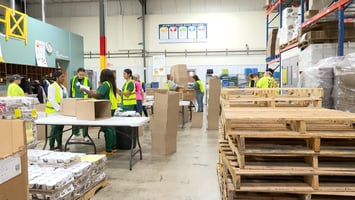If you’re thinking about volunteering for LA wildfire relief, we have put together this resource...
The Increasing Role of Technology in Hunger Relief Efforts
Technology is playing an increased role in streamlining and improving hunger relief efforts, to eliminate food waste and improve donation systems.
Global hunger is likely the most complex and persistent humanitarian issue. It plagues both wealthy and developing countries alike. The United Nations’ SOFI report (2024) indicates that hunger has increased substantially since the COVID pandemic. It has plateaued for three years, with over 700 million people facing food insecurity in 2023.
Causes for hunger are interrelated. They include higher prices, inflation, food waste, climate change, and global conflict. Considering all these problems, it is challenging for food relief agencies to understand the best places to allocate resources and the most efficient ways to collect resources.
However, improved technological solutions are offering a beacon of hope. Artificial intelligence (AI) integrations are improving efficiency and the speed of data sharing. And blockchain solutions help agencies like the World Food Programme track resource allocation. These improvements and others make it more realistic to achieve the Global Goal of Zero Hunger.
What follows is a synopsis of technological advancements for hunger relief. Then, we discuss how these new advancements, specifically with donation and volunteer management, can help food relief agencies in America and globally improve their capacity.
How Technology Advancements Are Supporting Hunger Relief

One of the challenges for food relief agencies is accessing and analyzing data on when, where, and how to best allocate resources. Data analytics can help agencies optimize their resource allocation. Here are some examples.
- AI can now analyze huge global datasets to identify trends in food consumption and donations. It can also predict food shortages and help with mapping.
- AI-empowered predictive analytics can help organizations prepare for crises before they happen. This helps organizations like the World Food Programme, the largest global relief effort, know where they need to send food and even what type of food.
- AI can also help improve supply chains and minimize waste by helping agencies better understand what food is being consumed and where. This analysis can quicken the redistribution of food to places in need before it expires.
These integrations are most helpful through the innovations of new mobile apps and digital platforms that connect stakeholders in the food relief ecosystem. They are linking donors and recipients in new ways that enhance collaboration and stimulate new giving.
- Platforms like Too Good To Go link restaurants and supermarkets with excess food to local food banks and charities. Donors can pinpoint who needs their particular excess food, in real time.
- Other systems like Golden’s volunteer management platform empower individuals to become grassroots advocates, understanding immediately which relief efforts need volunteer or donation support.
- Community-based apps from local nonprofits connect people in new ways and helping local agencies share resources more efficiently.
How Technology is Improving Online Food Donations
A specific way technology improves hunger relief efforts is through donation efficacy. Along with helping food donors like supermarkets and restaurants to reduce food waste through swifter allocations, programs are simplifying individual and corporate donations.
Platforms like Classy and Fundraise Up have user-friendly interfaces and secure payment systems that smoothly integrate with Salesforce and other CRM systems.
- Donors can contribute in a few clicks, choosing one-time payments, recurring donations, or even cryptocurrency.
- These platforms support scalability, by supporting multiple levels and types of giving, from small individual contributions to large corporate sponsorships.
- Integrated social sharing enables donors to become part of campaigns and share information amongst their networks to broaden reach and impact.
Golden is a special example of integration innovation, supporting fundraising tools directly within its volunteer management software. The platform’s AI eases tracking and personalizes communication through a new holistic approach to supporting hunger relief.
Features include branded and customizable campaign pages and gamification for rewards with partners like Karats. Users can link with their social media to extend information throughout their networks. These types of tools are helping organizations utilize their volunteer base in new ways, to help where needed most with time and energy, and also support campaigns financially.
How Fundraising Technology is Improving Efficiency for Food Relief Efforts
Improved fundraising tools reduce the time and effort required for campaigns in a number of ways. Foremost, they automate repetitive tasks like donor tracking and payment processing. They also help automate email campaigns and other outreach tactics. Reducing time for these tasks enables organizations to scale efforts and also to focus on improved donor interactions.
One of the most effective changes is improved customer relationship management (CRM) software, most notably Salesforce. Salesforce integration with volunteer platforms like Golden enhance operational efficiency even further by consolidating volunteer coordination and donor management in one system. Organizations can sync data, track donor activity, and see insights in real-time with customized dashboards. Furthermore, integrated CRM empowers organizations to tailor fundraising campaigns and personalize messaging.
The Impact of Streamlined Processes on Hunger Relief

All of these new apps, integrations, and resources are beginning to transform food relief efforts, improving our global capacity to reach the Zero Hunger goal. Here is a summary of the top impacts.
- Resource Allocation: Data is helping organizations reduce waste and improve the speed of delivery for the people most in need.
- Efficiency: Automation is improving operational efficiency, including aspects of inventory management, donor tracking, and volunteer coordination.
- Donor Engagement: Online fundraising platforms and mobile apps make donating easier and more appealing, supporting more participation. Streamlined donation processes, customizable campaigns, and social sharing improve efforts.
- Real-Time Collaboration: Apps at both global and local levels are connecting the stakeholder ecosystem in real time, from donors to food banks to volunteers.
- Scalability: Organizations can better map and predict where need is and where it will be, to improve their capacity to scale.
- Transparency: Improved tracking capacity, including blockchain integrations and RFID tracking of food from farm to table, creates more transparency and trust for donors and agencies.
Technology-Driven Partnerships
Partnerships between hunger relief organizations and technology providers are transformative, linking the mission-driven focus of non-profits with latest innovation.
Classy, a fundraising platform, has helped hunger relief organizations like Feeding America and Meals on Wheels raise millions of dollars with online campaigns. One notable campaign by Feeding America leveraged Classy to engage corporate partners and individual donors, raising funds to distribute millions of meals nationwide.
Similarly, Golden’s volunteer management platform has been instrumental in creating new solutions for food relief agencies. Feeding America and other large regional food banks partner with Golden to recruit and manage volunteers for food distribution events. The system enables these partners to facilitate fundraising drives with those volunteer networks, amplifying impact through volunteer social sharing. This way, organizations can better utilize their volunteers to give both time and financial support.
The Future of Technology in Hunger Relief
One of the top emerging trends is using blockchain for transparency. The World Food Programme has improved efficiency in donations for hundreds of millions with blockchain tech. Platforms like Binance Charity are creating capacity for even more organizations, of all sizes, to track their donation impact.
Also, AI will continue to play an increasing role for optimizing operations and supporting predictive analysis. Broader application will improve the logistics to ensure food surplus is not wasted, reducing the 40% food waste gap in developed countries and supporting more efficient re-allocation.
Future efforts will increasingly rely on platforms like Golden to streamline volunteer recruitment, training, and coordination, merging what were once separate worlds in the nonprofit and food relief sectors. Integrations between these types of technologies and systems will only improve and grow over time, creating a new normal for efficiency and impact.


